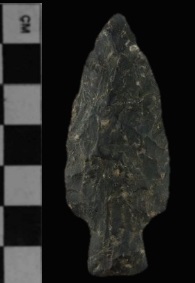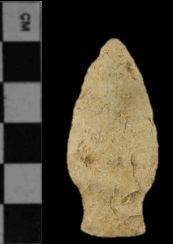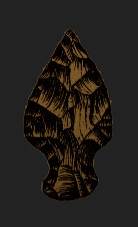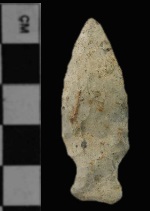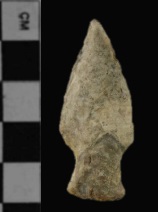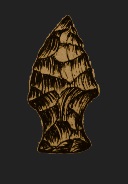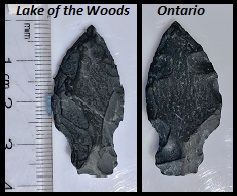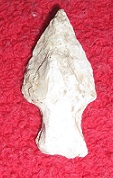Outline is Representative of Size and Shape:

Name Details:
Identified By: Warren L. Wittry
Named For: Type Site
Date Identified: 1959
Type Site: Durst Rockshelter, Sauk County, Wisconsin
Identified By: Warren L. Wittry
Named For: Type Site
Date Identified: 1959
Type Site: Durst Rockshelter, Sauk County, Wisconsin
Point Validity:
Valid type
Emerson is a distinguished anthropologist and professor at the University of Illinois. He has conducted extensive studies into the archaeology of the American Bottoms and is well-published. This type was named in a professional publication and has many professional references. This is considered a valid type.
Emerson is a distinguished anthropologist and professor at the University of Illinois. He has conducted extensive studies into the archaeology of the American Bottoms and is well-published. This type was named in a professional publication and has many professional references. This is considered a valid type.
Durst Stemmed
Cluster: Lamoka Cluster Description of Physical Characteristics and Flaking Pattern:
This is a small to medium thick triangular expanding stem point with an elliptical cross section. The blade is primarily excurvate with some smaller points having a straighter blade. Parallel notches are generally twice as wide as they are deep with a shoulder that tends to be sloping upwards, though many examples have horizontal shoulders. The stem is commonly expanding, but may be slightly expanding or straight. The base is primarily convex to straight and commonly ground. This point is manufactured with roughly flaked percussion and pressure flaking forming a random flaking pattern and are crudely made.
Size Measurements:
Length - 21 to 70 mm (average 35 mm), Stem Length - 11 to 15 mm (typically 1/3 of the total length), Blade Width - 13 to 29 mm, Neck Width - 7 to 12 mm, Stem Width - 8 to 16 mm, Thickness - 5 to 10 mm.
Length - 21 to 70 mm (average 35 mm), Stem Length - 11 to 15 mm (typically 1/3 of the total length), Blade Width - 13 to 29 mm, Neck Width - 7 to 12 mm, Stem Width - 8 to 16 mm, Thickness - 5 to 10 mm.
Commonly Utilized Material:
A variety of heat treated local cherts
A variety of heat treated local cherts
Additional Comments:
Points in this cluster are usually a smaller, cruder, and thicker point (W2).
The University of Minnesota has this cluster listed as a Durst Stemmed cluster, Justice (1987) lists this cluster as the Lamoka cluster. This cluster has been listed as the Lamoka Cluster here.
The Durst Stemmed, Dustin, and Lamoka are considered the same point with different names based on the distribution. This point is called the Lamoka point in from northern Ohio east, the Dustin point in Michigan area, and the Durst Stemmed point from northern Illinois east (W2 / Justice 1987). These points are being listed separately in order to listed the name details and distribution of each. It should also make regional identifications easier.
This point is similar to the Table Rock, Bottleneck, and Apple Blossom, but tend to be more crudely made than these types.
Points in this cluster are usually a smaller, cruder, and thicker point (W2).
The University of Minnesota has this cluster listed as a Durst Stemmed cluster, Justice (1987) lists this cluster as the Lamoka cluster. This cluster has been listed as the Lamoka Cluster here.
The Durst Stemmed, Dustin, and Lamoka are considered the same point with different names based on the distribution. This point is called the Lamoka point in from northern Ohio east, the Dustin point in Michigan area, and the Durst Stemmed point from northern Illinois east (W2 / Justice 1987). These points are being listed separately in order to listed the name details and distribution of each. It should also make regional identifications easier.
This point is similar to the Table Rock, Bottleneck, and Apple Blossom, but tend to be more crudely made than these types.
Distribution: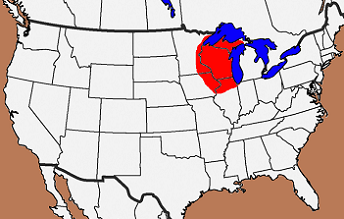

Distribution Comments:
This is a regional name for the Lamoka point found in northern Illinois, eastern Iowa, southeastern Minnesota, and throughout Wisconsin. See additional comments regarding Ohio River valley distribution.
This is a regional name for the Lamoka point found in northern Illinois, eastern Iowa, southeastern Minnesota, and throughout Wisconsin. See additional comments regarding Ohio River valley distribution.
Age / Periods:
Date: 3,500 - 2,500 B.P.
Cultural Period: Late Archaic
Glacial Period: Neoglacial
Culture:
Date: 3,500 - 2,500 B.P.
Cultural Period: Late Archaic
Glacial Period: Neoglacial
Culture:
Age Details:
Durst points are associated with a radiocarbon date of circa 800 to 600 B.C.E. at Site 13CT228 in Clayton County, northeast Iowa (Whittaker et al. 2007).
Durst points are associated with a radiocarbon date of circa 800 to 600 B.C.E. at Site 13CT228 in Clayton County, northeast Iowa (Whittaker et al. 2007).
Other points in this cluster / Related / Associated Points:
Bare Island, Dustin, Lamoka, Normanskill, Wading River
Bare Island, Dustin, Lamoka, Normanskill, Wading River

